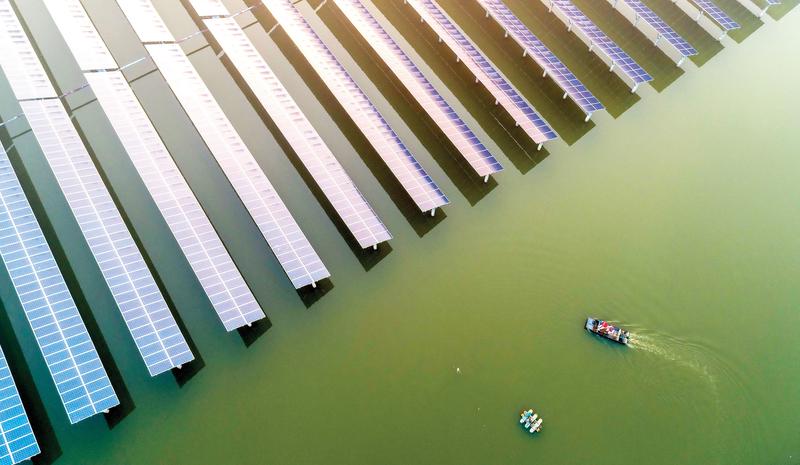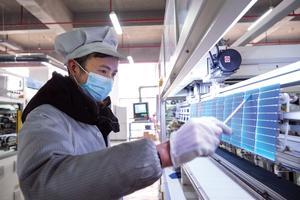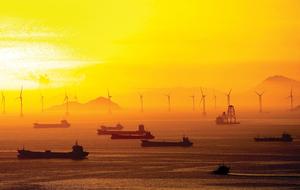 Workers in a boat reach a water-based solar farm at Nandang village in Xinghua, a county-level city in Jiangsu province, on Dec 24. China’s solar power industry is expected to have a bigger share in the country’s energy mix this year. (TANG DEHONG / FOR CHINA DAILY)
Workers in a boat reach a water-based solar farm at Nandang village in Xinghua, a county-level city in Jiangsu province, on Dec 24. China’s solar power industry is expected to have a bigger share in the country’s energy mix this year. (TANG DEHONG / FOR CHINA DAILY)
China’s solar power segment is expected to achieve faster growth, playing an even bigger role in the country’s energy industry this year.
That will come against the backdrop of China’s goals to allow carbon emissions to peak before 2030 and achieve carbon neutrality before 2060, experts said.
Solar power is expected to surpass wind power as the third-largest power source in the country.
China is aiming to come up with another 70 gigawatts to 90 gigawatts of solar installed capacity on average each year during the 14th Five-Year Plan period (2021-25).
If the plan pans out, China will take the lead in photovoltaic development globally.
The country boasts an internationally competitive and complete industrial chain, said Wang Bohua, secretary-general of the China Photovoltaic Industry Association.
Newly added solar power installations during the 2016-20 period were five times that of the previous five years, as China makes steady progress in the adoption of clean energy, according to the association.
China exhibited strong resilience against the impact of the COVID-19 pandemic, bringing about 40 GW of new solar power into operation last year, up almost 33 percent year-on-year, and taking its total installed solar capacity to 240 GW, Wang said.
Industry insiders said subsidies from the government, cost cuts and advancements in technology have been driving the rapid development of the country’s photovoltaic industry.
According to Wang, future development of renewables, including wind and solar power, will not need State subsidies, thanks to sharply falling costs brought about by technological advances.
“There is generally no need for the government to subsidize wind, solar and other new energies. They will primarily be driven by the market,” he said. “The biggest issue is how to best utilize these new energies.”
 A worker examines photovoltaic cells at a workshop of Anhui Daheng Energy Technology Co Ltd in Hefei, Anhui province, on Jan 6. The workshop produces smart solar panels. (ZHAO MING / FOR CHINA DAILY)
A worker examines photovoltaic cells at a workshop of Anhui Daheng Energy Technology Co Ltd in Hefei, Anhui province, on Jan 6. The workshop produces smart solar panels. (ZHAO MING / FOR CHINA DAILY)
Shi Jingli, a researcher with the China Renewable Energy Center, which is affiliated with the National Development and Reform Commission, expects China to enter the era of grid price parity in the 14th Five-Year Plan period.
He suggested that regulators work out policies to help continue enhancing technology upgrades and reducing costs for the solar power industry, as technological advances and lower costs are the major drivers of the industry’s development.
In addition to solar power, China will increase the shares of other clean energy sources, including wind, hydrogen and nuclear, in its energy mix, as the country is committed to playing its part in the global fight against climate change.
China is the world’s largest renewable energy market and the largest clean energy equipment manufacturer. The country’s coal consumption accounted for nearly 58 percent of its total energy consumption in 2019 (data for 2020 remains to be confirmed as of press time). That was almost 11 percentage points lower than that in 2012.
Consumption of natural gas, hydropower, nuclear power and wind power in 2019 accounted for 23.4 percent of the country’s total energy consumption, 8.9 percentage points higher than that in 2012, according to a white paper titled Energy in China’s New Era, published by the State Council Information Office in December.
Consumption of non-fossil fuels accounted for 15.3 percent of total energy consumption last year, 5.6 percentage points higher than that in 2012 and surpassing the 15 percent goal set for 2020, it said.
Analysts said China’s solar industry, despite suffering delays in the early days of the pandemic, has shown resilience and is now operating in full swing.
According to Liu Yujing, an analyst with BloombergNEF, China is likely to become more determined to develop renewable energy as part of its efforts to reduce energy imports from a longer-term perspective.
China has vowed to boost its share of non-fossil fuels in primary energy consumption to around 25 percent and increase the installed capacity of wind and solar power to more than 1,200 GW by 2030.
It also aims to lower its carbon dioxide emissions per unit of GDP by over 65 percent from the 2005 level.
Zhou Dadi, vice-president of the China Energy Research Society, said China’s energy structure will experience fundamental changes as the share of fossil energy in the primary energy mix is set to decline sharply while the share of renewables will likely grow rapidly, so as to achieve the carbon neutrality goal.
His view found an echo in Liu Yiyang, deputy secretary-general of the China Photovoltaic Industry Association. Liu said the output of the country’s newly installed solar projects will reach over 65 GW per year from this year to 2025.
 Fishing vessels provide a neat foreground to an offshore wind farm near Guishan island of Zhuhai, Guangdong province, on Nov 19. (ZHOU GUOQIANG / FOR CHINA DAILY)
Fishing vessels provide a neat foreground to an offshore wind farm near Guishan island of Zhuhai, Guangdong province, on Nov 19. (ZHOU GUOQIANG / FOR CHINA DAILY)
According to BloombergNEF, a provider of primary research on clean energy, advanced transport, digital industry, innovative materials and commodities, China is the biggest emerging market for clean energy investment, which “appears to weather the coronavirus storm better than other sectors of the global economy so far”.
Developing countries including China have made “massive strides “in the last decade in attracting clean energy capital and building unprecedented volumes of wind and solar capacity, it said.
The research firm called for a sustainable recovery from the COVID-19 pandemic by making the best possible use of public finances to attract private investment from both national and international investors.
Many companies are also laying out plans for further exploring the new energy potential in China.
State Power Investment Corp, the world’s largest investor in solar power-generating plants, said it will further stepup investment in clean energy.
It plans to raise its installed power capacity to more than 220 GW by 2025, with more than 60 percent being clean energy, including hydropower, wind power and photovoltaic, as well as energy storage.
According to Qian Zhimin, chairman of State Power Investment Corp, profits from clean energy have been far more than those from the traditional fossil fuels in recent years.
Despite the pandemic, the company still saw a stable rise in its net profit, which Qian attributed to the development of clean energy.
Shell, a leading international oil retailer in China, also sees huge potential in the country’s new energy sector.
According to Huibert Vigeveno, the company’s downstream director, Shell is optimistic about the potential in China’s hydrogen sector and will further involve itself in China’s hydrogen projects. Shell unveiled its first commercial hydrogen project in China in November.
The joint venture with Zhangjiakou City Transport intends to advance the development of hydrogen and clean energy in the region and supply refueling stations in Zhangjiakou, a prefecture-level city in Hebei province, one of the co-hosts of the Beijing 2022 Winter Olympics, he said.
Although the heavy haul transportation industry still prefers liquefied natural gas as the midterm solution to meet its heavy demand, hydrogen will likely emerge as the answer in the long run, Vigeveno said.
He also said the company foresees more than 50 hydrogen refueling stations worldwide, including those in Germany, the Netherlands and the United Kingdom, benefiting from the experiences in China.


